As an Amazon Associate KitchenwareSets.com earns from qualifying purchases.
7 Minimalist Japanese Kitchen Shelving Ideas To Try Now
Is your kitchen clutter working against your peace of mind? If you’ve ever felt overwhelmed by countertops crowded with appliances, cabinets overflowing with mismatched containers, and a general sense of visual noise, you’re not alone. The heart of the home can easily become a source of daily stress, making simple tasks like preparing a meal feel chaotic and disorganized. This constant battle with clutter isn’t just an inconvenience; it can genuinely impact your sense of calm and well-being.
Imagine a kitchen that feels serene, open, and incredibly functional—a space where everything has a purpose and a place. This is the core philosophy behind Japanese kitchen design. We’ve delved into hundreds of designs and spoken with home organization experts to curate ideas that truly blend Japanese aesthetics with everyday functionality. The solution is simpler than you think and doesn’t require a full-scale renovation.
Minimalist Japanese kitchen shelving focuses on simplicity, natural materials, and functionality to create an organized, serene, and clutter-free environment. It achieves this by championing elements like intentional open shelving, the warmth of natural wood, and clever space-saving designs. We’ve gathered 7 specific, achievable shelving ideas that will help you transform your kitchen from a place of stress into a sanctuary of calm efficiency.
7 Minimalist Japanese Kitchen Shelving Ideas To Try This Weekend
These seven ideas are more than just storage solutions; they are invitations to create a kitchen that is calming, beautiful, and highly functional. Each concept is a step towards a more mindful and organized home, transforming the way you interact with your space. Each idea is selected for its practicality in modern homes, drawing from authentic Japanese design principles for a look that’s both timeless and fresh for 2025.
1. Embrace Open Shelving for Showcase Storage
Embracing open shelving means you thoughtfully display only your most beautiful and frequently used items, turning everyday objects into a curated, functional showcase. This approach forces intentionality, reducing clutter by design and creating a light, airy feeling in your kitchen.
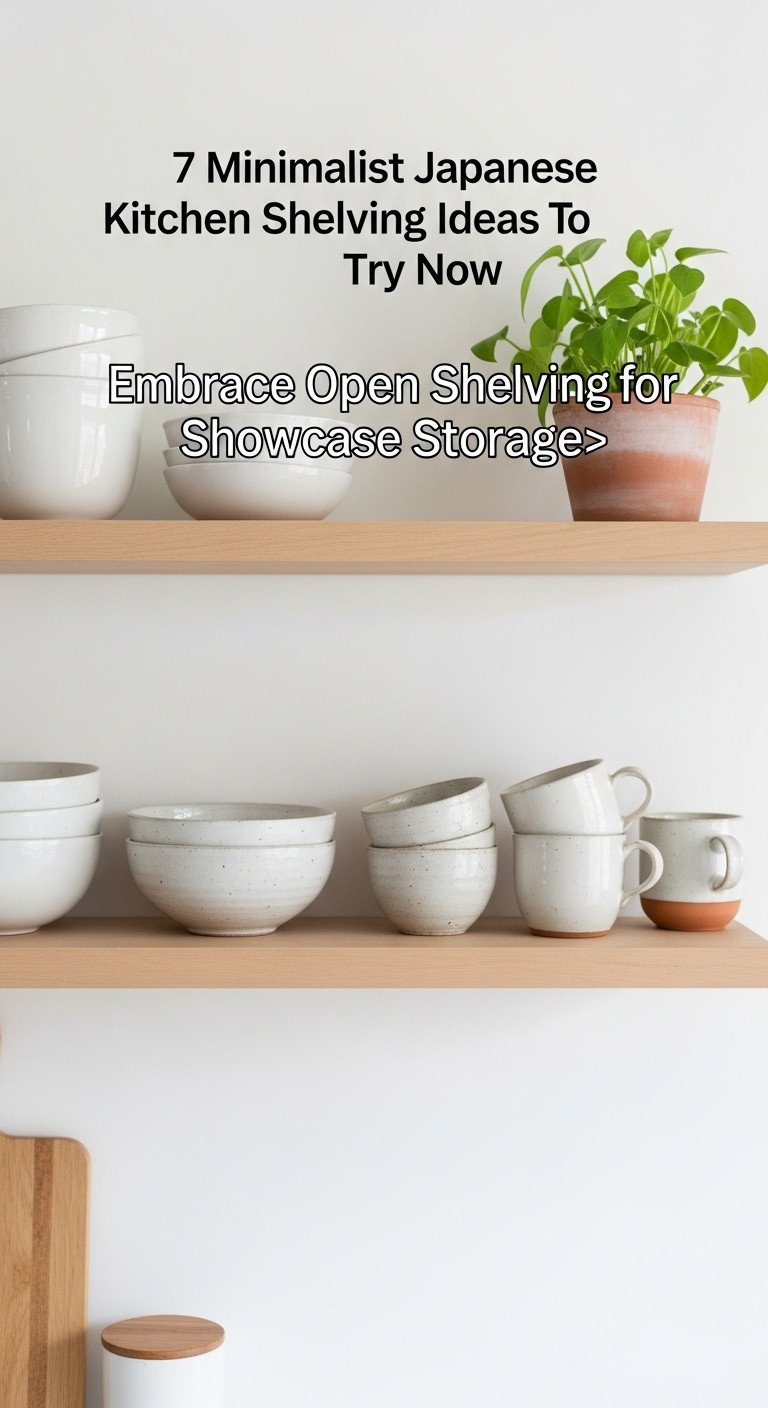
Pin this minimalist shelf inspiration for your kitchen refresh!
- Materials Needed: Open shelving kit or individual shelves, wall brackets, level, drill, wall anchors.
- Step-by-Step Directions:
- Declutter First: Begin by selecting only your most frequently used or most beautiful items (e.g., daily dishes, mugs, a few serving bowls). This is the core of “showcase storage.”
- Choose a Focal Point: Install the shelves on a main wall, creating a visual centerpiece for the kitchen. Ensure they are perfectly level.
- Arrange with Intention: Group items by color or function. Leave negative space between items to avoid a cluttered look. Aim for balance, not perfect symmetry.
- Incorporate Natural Elements: Add a small potted plant or a wooden cutting board to introduce texture and warmth. A high-quality set of matching minimalist storage canisters can also provide function and beauty.
Pro-Tip: Rotate the items on your shelves seasonally. This keeps the display fresh and allows you to use a wider range of your kitchenware without creating permanent clutter.
2. Utilize Natural Wood Floating Shelves for Warmth
Using natural wood floating shelves is the perfect way to introduce organic warmth and a clean, seamless look to your kitchen. The absence of visible brackets creates a minimalist aesthetic, allowing the beautiful grain of the wood—like oak, walnut, or ash—to become a natural decorative element.
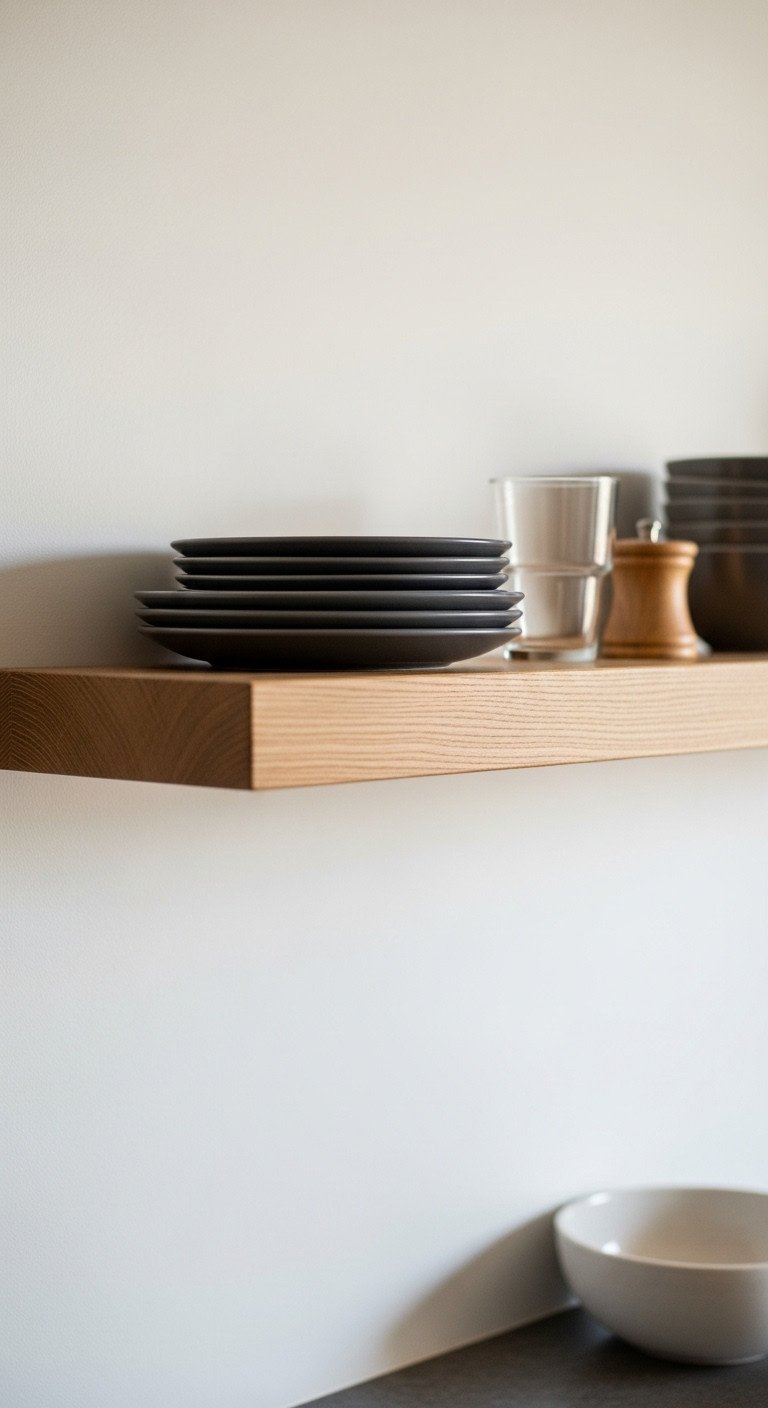
Save this warm wood shelving idea to your ‘Japandi Home’ board!
- Materials Needed: Solid wood floating shelf kit (e.g., oak, walnut), heavy-duty concealed brackets, drill, level, stud finder.
- Step-by-Step Directions:
- Select Your Wood: Choose a wood type that complements your existing cabinetry and countertops. Light oak or ash are classic Japandi choices.
- Find the Studs: Use a stud finder to locate wall studs for a secure installation. Floating shelves, especially those holding dishes, need robust support from heavy-duty floating shelf brackets.
- Install the Bracket: Mount the concealed metal bracket securely to the wall studs, ensuring it is perfectly level.
- Slide on the Shelf: Slide the hollowed-out wood shelf onto the bracket for a seamless, floating appearance.
- Style Minimally: Adhere to the “minimal items, maximum openness” philosophy. Display only a few select items to let the beauty of the wood shine through.
Lesson Learned: Always check the weight capacity of your floating shelf brackets. It’s better to choose brackets that are rated for more weight than you think you’ll need, especially for storing heavy ceramic dishes.
3. Incorporate Slim Wall-Mounted Shelves for Small Spaces
Incorporating slim, wall-mounted shelves allows you to maximize vertical storage in compact areas, turning unused wall space into a highly functional and stylish organization hub. These shelves are perfect for keeping everyday essentials accessible without cluttering precious counter space.
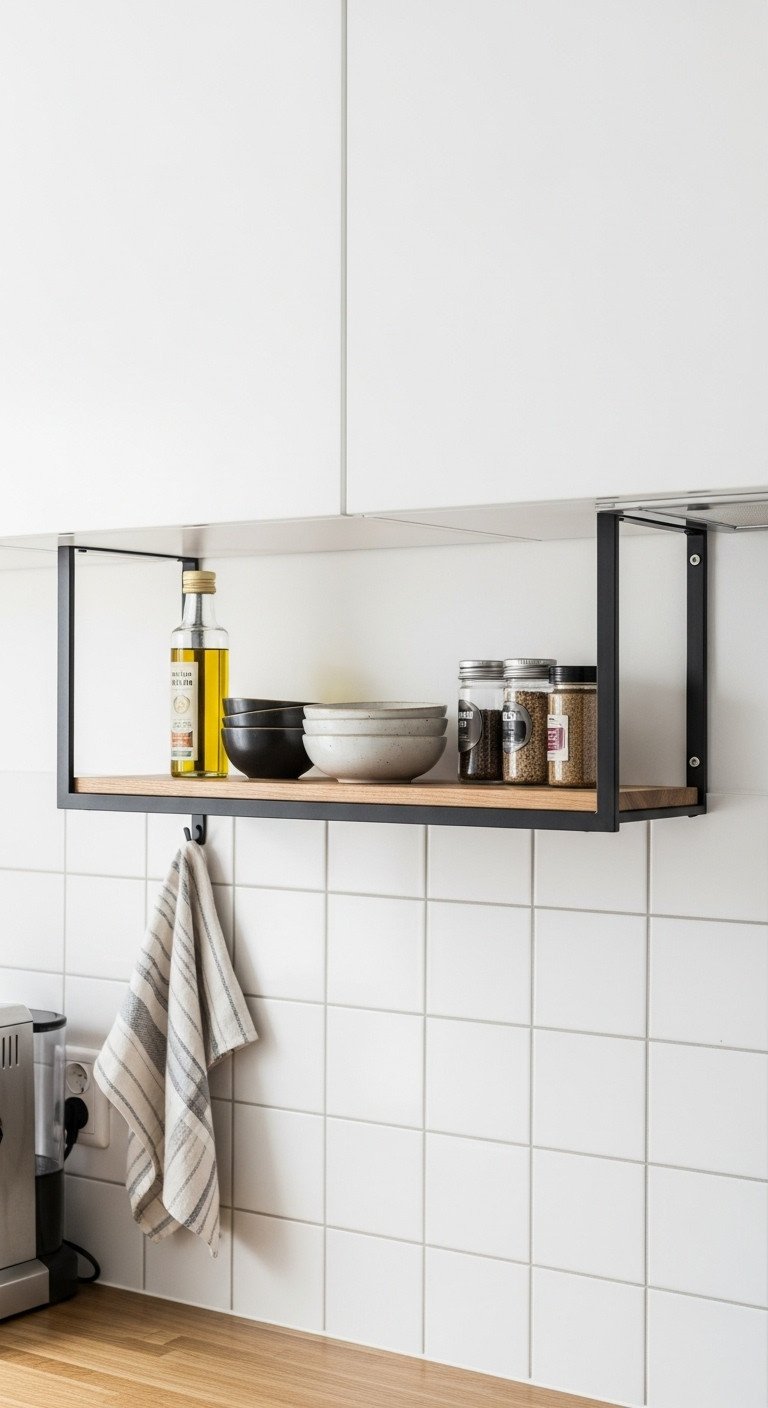
Love this space-saving idea? Pin it for your small kitchen!
- Materials Needed: Wall-mounted shelf unit (like a Yamazaki-style rack), drill, appropriate wall anchors, level.
- Step-by-Step Directions:
- Identify Unused Space: Look for narrow vertical spaces, such as beside a window, above the sink, or near the stove.
- Choose the Right Shelf: Opt for a slim, multi-tiered unit to maximize vertical storage. A 2-tier kitchen storage rack is perfect for this, often combining a shelf with hooks for utensils.
- Secure Installation: Follow the manufacturer’s instructions to mount the shelf securely to the wall, using anchors suitable for your wall type (drywall, tile, etc.).
- Organize by Use: Place frequently used items like spices, oils, and daily-use mugs on the shelf for easy access, keeping your countertops clear.
Pro-Tip: Magnetic wall-mounted shelves are a fantastic renter-friendly option for storing knives or spices without drilling into a backsplash.
4. Design Built-in Shelves for Seamless Integration
Designing built-in shelves means you create storage that appears to be part of the kitchen’s original architecture, offering a high-end, custom look. By painting them the exact same color as the walls, you create a seamless and cohesive design that makes any nook or awkward space feel intentional and beautifully integrated.
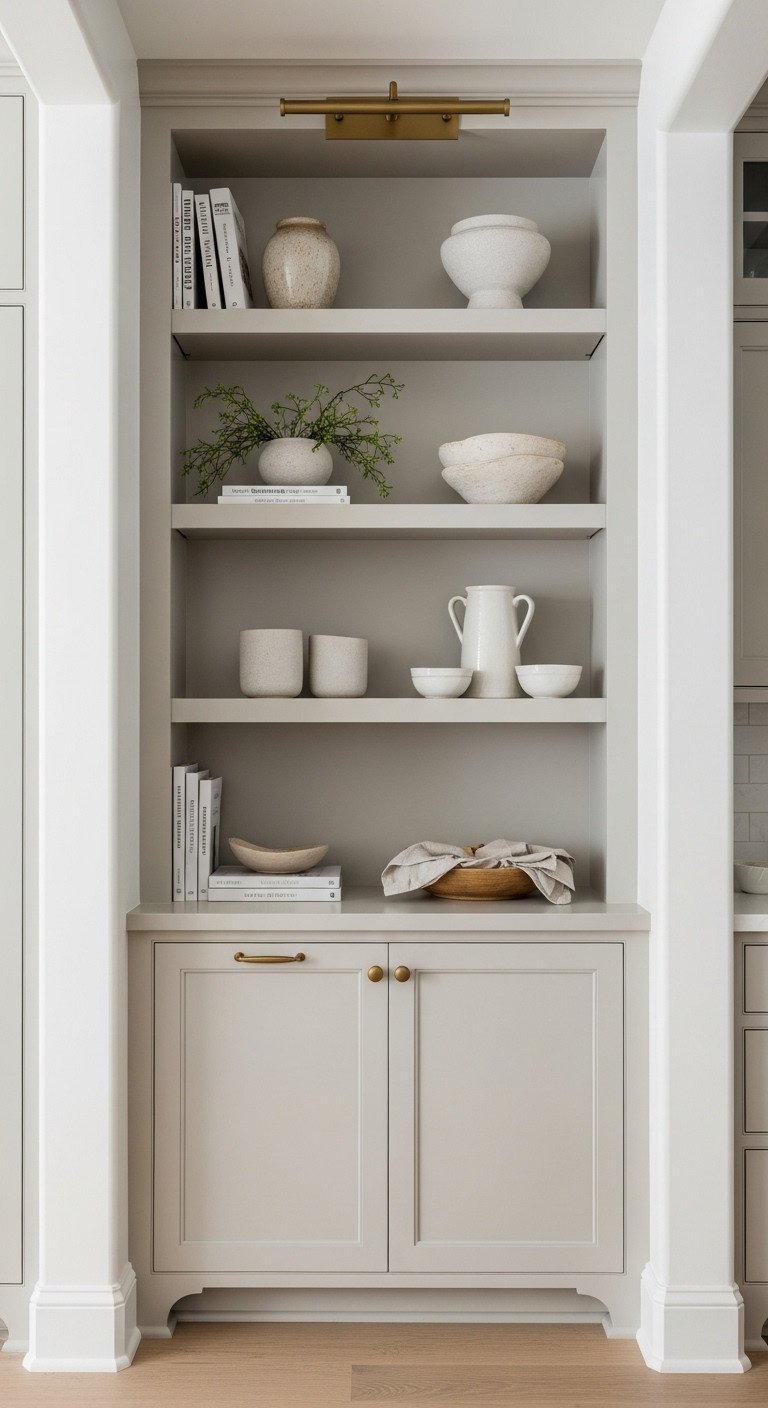
Pin this seamless storage idea for a custom kitchen look!
- Materials Needed: MDF or plywood sheets, wood glue, finishing nails, primer, paint matching your wall color, measuring tape, saw.
- Step-by-Step Directions:
- Find a Nook: Identify an awkward or unused space, like the end of a cabinet run or a recessed wall area.
- Measure and Cut: Carefully measure the space and cut your wood or MDF pieces to create a simple box frame and shelves.
- Assemble: Use wood glue and finishing nails to assemble the shelving unit.
- Prime and Paint: Prime the entire unit and then paint it with the exact same paint color and finish as your walls. This is the key to the seamless, built-in look.
- Install: Secure the unit into the nook. For a simpler approach, a slim, tall kitchen storage tower can create a similar effect when placed in a narrow gap.
Pro-Tip: If building from scratch feels daunting, find a pre-made bookshelf or slim shelving unit that fits your nook perfectly and paint it to match the walls. It’s a great DIY hack for a custom look.
5. Curate Functional Displays with Aesthetic Appeal
Curating a functional display involves choosing and arranging everyday items so they are both useful and visually harmonious. The goal is to ensure that everything on your shelves serves a practical purpose while contributing to a serene, beautiful atmosphere, turning tools into decor.
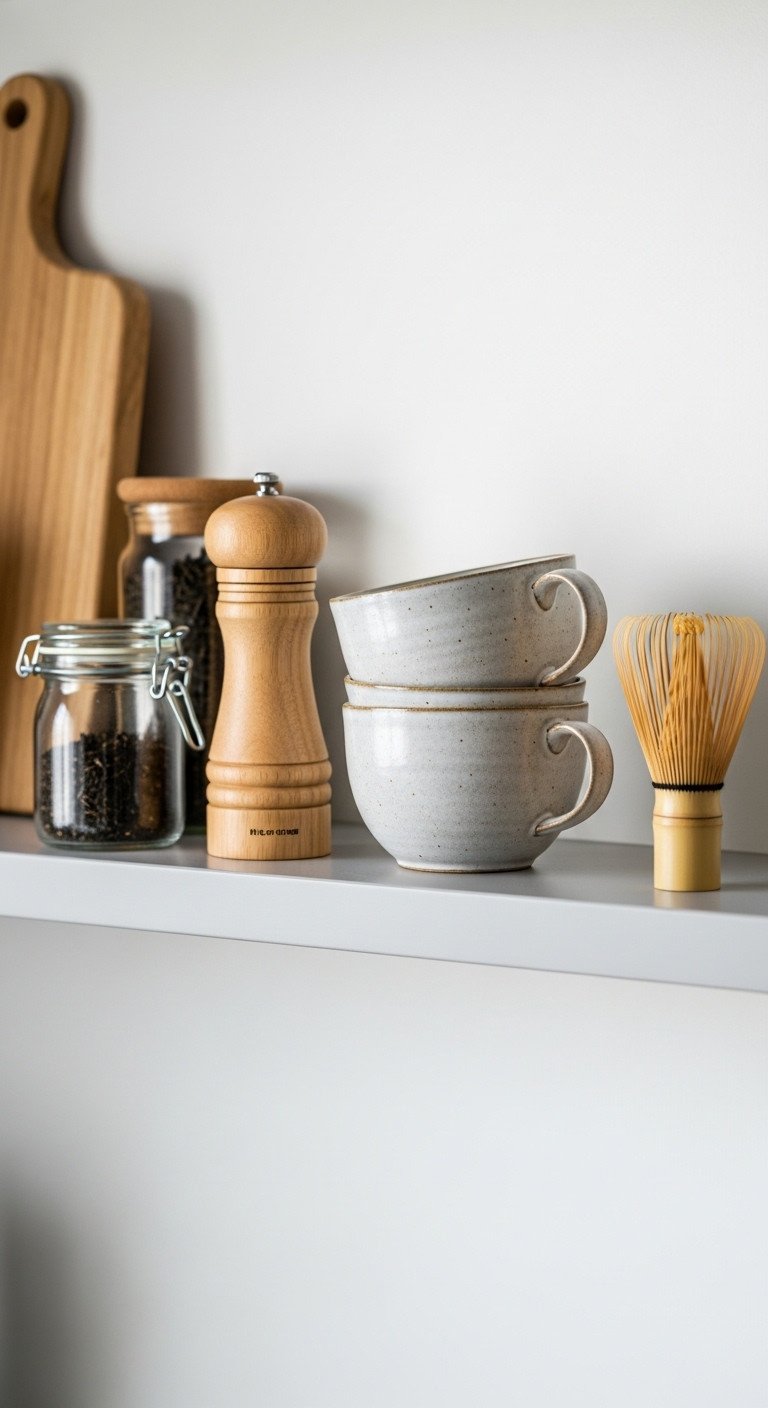
Get inspired to style your shelves—pin this beautiful display!
- Materials Needed: Your existing kitchenware, plus potential additions like matching storage jars, a beautiful oil cruet, or a set of wooden utensils.
- Step-by-Step Directions:
- Edit Ruthlessly: Remove anything from your shelves that is not genuinely useful or beautiful.
- Decant and Unify: Transfer pantry staples like flour, sugar, and pasta from their chaotic packaging into uniform, minimalist glass or ceramic storage jars. This instantly creates a cohesive look.
- Invest in “Tool Decor”: Choose everyday tools that are beautiful in their own right, such as an acacia wood utensil holder, a sculptural salt cellar, or a matched set of stoneware mugs.
- Group by Function: Keep all your coffee-making supplies together or group your baking spices. This is both practical and visually pleasing.
Lesson Learned: The biggest mistake is overcrowding. It’s better to have one beautiful, functional item on a shelf than five mediocre ones. Embrace the empty space.
6. Create Depth by Balancing Light and Dark Elements
Creating depth with balance means you strategically use high-contrast elements, like dark accessories on light wood shelves, to add visual interest and sophistication. This Japandi-inspired technique prevents a minimalist space from feeling flat by introducing a dynamic interplay between light and shadow.
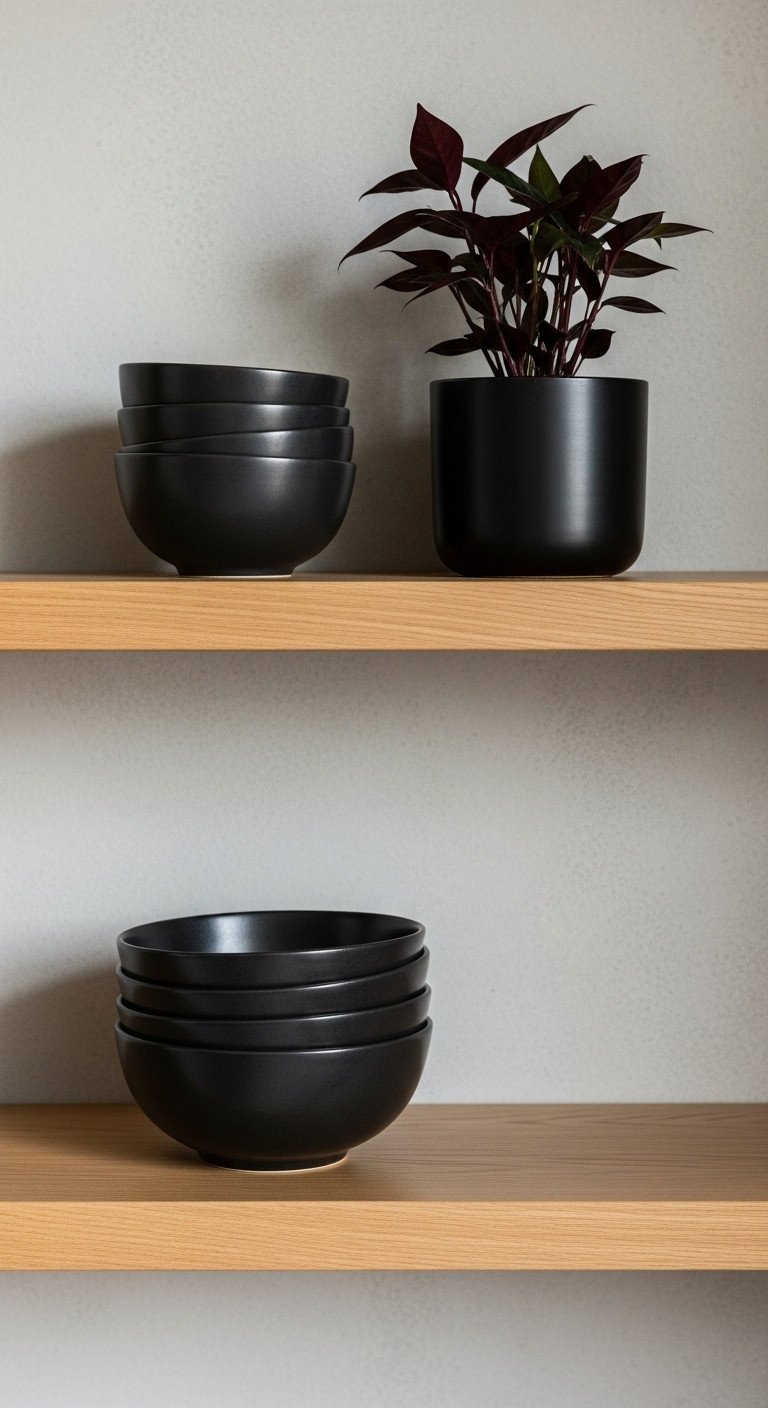
Love this high-contrast look? Save it to your ‘Modern Kitchen’ board!
- Materials Needed: Your existing light-colored shelves or cabinetry, and new dark accent pieces.
- Step-by-Step Directions:
- Start Small: You don’t need to overhaul your kitchen. Begin by introducing small, dark elements.
- Swap Hardware: If you have floating shelves with visible brackets, swap them for sleek, matte black floating shelf brackets. This is a simple but impactful change.
- Curate Dark Objects: Style your light wood shelves with dark items: a set of black stoneware plates, charcoal gray mugs, or dark-colored storage canisters.
- Add a Black Frame: A simple, black-framed piece of art leaning on a shelf can provide a powerful point of contrast.
Pro-Tip: The key to this look is maintaining a simple color palette. Stick to your primary light color (like white or cream), your wood tone, and black as your main accent. Avoid introducing too many other colors.
7. Add Coziness by Layering Natural Textures
Adding coziness through texture means you intentionally mix different tactile surfaces like rough earthenware, smooth wood, and soft linen to create a warm and inviting atmosphere. This layering prevents a minimalist design from feeling cold or sterile by appealing to the sense of touch and adding visual depth.
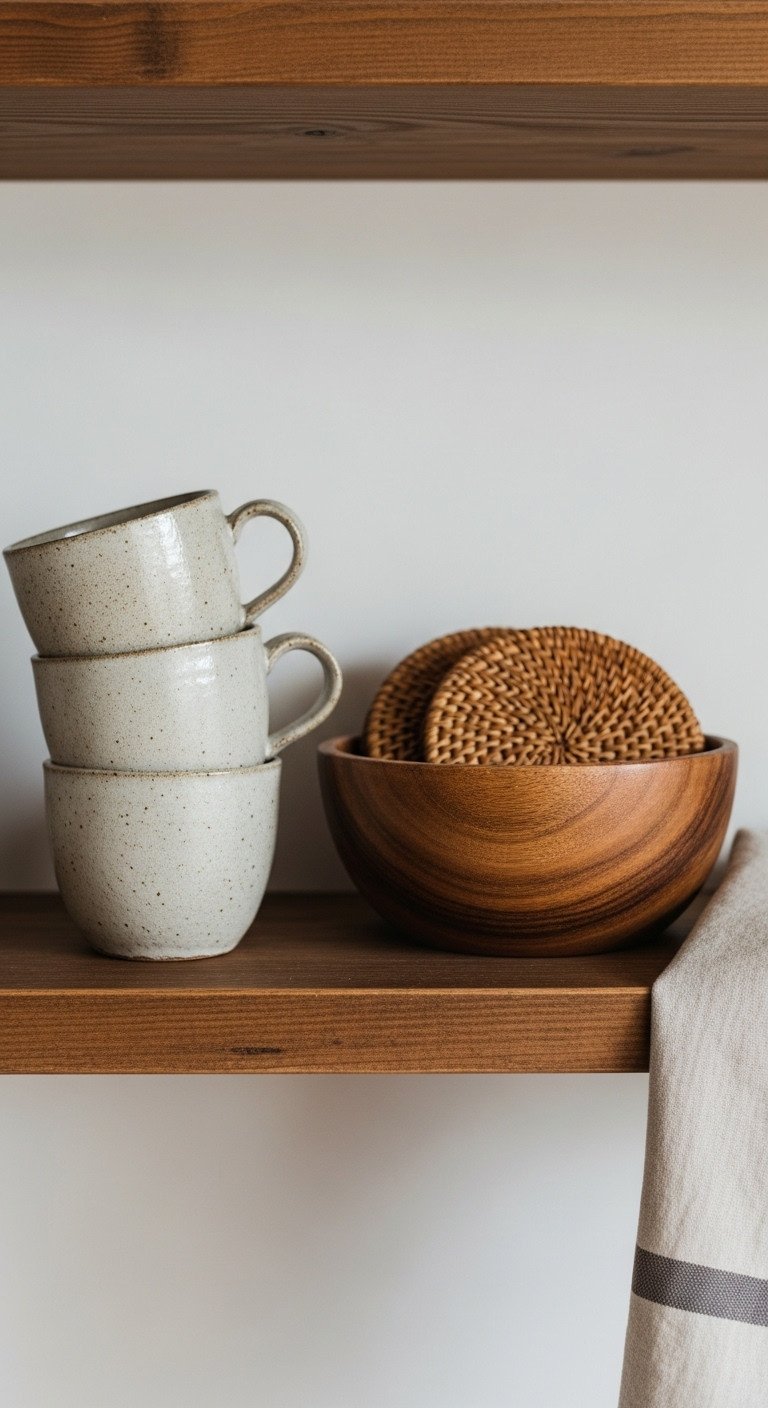
Pin this cozy, textured look for your dream kitchen!
- Materials Needed: Textured decor items like linen napkins, stone coasters, ceramic mugs, and wooden bowls.
- Step-by-Step Directions:
- Think Tactile: When styling your shelves, consciously mix different surfaces.
- Combine Materials: Place a set of rough, unglazed earthenware coffee mugs on your smooth wooden shelving. The contrast is immediately appealing.
- Incorporate Textiles: A small stack of linen napkins or a textured tea towel folded neatly on a shelf can add a layer of softness.
- Use Natural Accents: Add a small stone mortar and pestle, a wooden cutting board leaning against the wall, or a woven basket to hold fruit. These elements invite touch and add warmth.
Lesson Learned: Even subtle texture makes a difference. The contrast between a matte finish and a glossy one, or a smooth surface and a ribbed one, can elevate your entire display.
Key Takeaways: Your Quick Guide to Japanese Kitchen Shelving
- Function First: Every item on a shelf should have a purpose.
- Embrace Openness: Use open and floating shelves to create a light, airy feel.
- Natural Materials are Key: Incorporate wood, stone, and ceramic to add warmth.
- Less is More: Carefully curate what you display to avoid a cluttered look.
- Texture Adds Coziness: Mix smooth and rough surfaces to keep minimalism from feeling sterile.
@juicedkitchens Japanese kitchen design inspo for ppl who hate sad beige kitchens bookmark if you want to buy this magazine book (Mook) Title: Casa Brutus Kitchen & Tools edition Release: Feb 2025 ISBN: 9784838754427 #kitchendesign #kitchenrenovation #kitchendesignideas #japanesekitchen #greenscreen
People Also Ask About Japanese Kitchen Shelving
What are Japanese shelves called?
A traditional Japanese wooden shelf is known as a “tana” (棚), a word that embodies the core principles of Japanese design: simplicity, functionality, and aesthetics. Tana are often minimalist in design, highlighting the natural beauty of the wood and the craftsmanship involved in their creation.
Are open kitchen shelves still in style in 2025?
Yes, open kitchen shelves remain very much in style, especially within minimalist, modern farmhouse, and Japandi aesthetics. They have evolved from a passing trend to a timeless design choice for creating an open, airy, and personalized kitchen space. The key in 2025 is intentional curation, focusing on displaying beautiful, functional items rather than clutter.
What is the difference between kitchen and daidokoro?
“Daidokoro” (台所) is the traditional Japanese word for kitchen, while “kitchen” (キッチン) is the English loanword that is also commonly used in modern Japan. While they are often used interchangeably, “daidokoro” can sometimes carry a more traditional or formal nuance, referencing the heart of a Japanese home’s cooking space.
Final Thoughts
Transforming your kitchen into a serene, functional space doesn’t have to be an overwhelming project. By embracing the principles of Japanese shelving—simplicity, natural materials, and intentionality—you can create a significant impact on your daily life. These ideas prove that thoughtful organization is not just about storage; it’s about creating an environment that supports a calmer, more mindful way of living. Start with just one of these concepts this weekend and watch as your kitchen begins its transformation from chaotic to calm.
Which of these Japanese shelving ideas are you most excited to try in your own kitchen? Let us know in the comments below
Last update on 2025-10-14 at 22:45 / Affiliate links / Images from Amazon Product Advertising API
